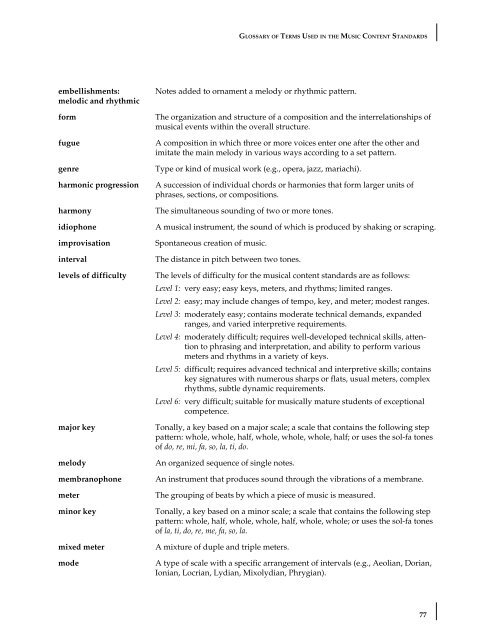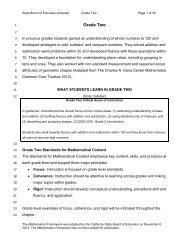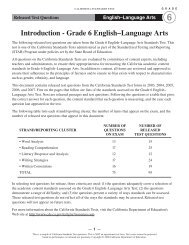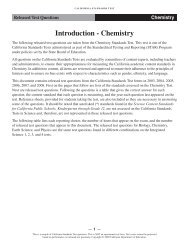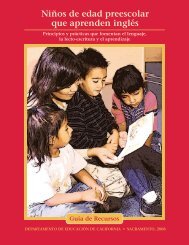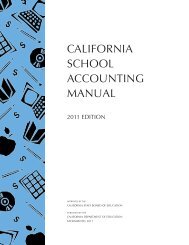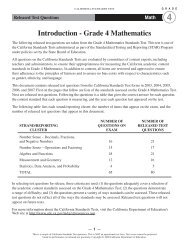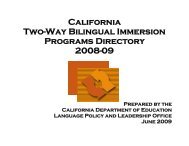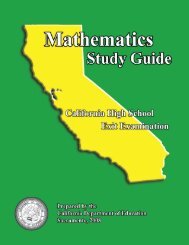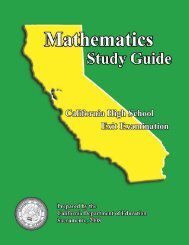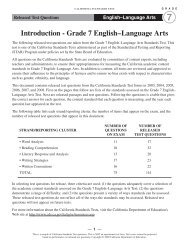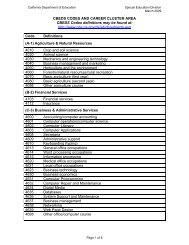Visual and Performing Arts Content Standards - California ...
Visual and Performing Arts Content Standards - California ...
Visual and Performing Arts Content Standards - California ...
Create successful ePaper yourself
Turn your PDF publications into a flip-book with our unique Google optimized e-Paper software.
GLOSSARY OF TERMS USED IN THE MUSIC CONTENT STANDARDS<br />
embellishments: Notes added to ornament a melody or rhythmic pattern.<br />
melodic <strong>and</strong> rhythmic<br />
form The organization <strong>and</strong> structure of a composition <strong>and</strong> the interrelationships of<br />
musical events within the overall structure.<br />
fugue A composition in which three or more voices enter one after the other <strong>and</strong><br />
imitate the main melody in various ways according to a set pattern.<br />
genre Type or kind of musical work (e.g., opera, jazz, mariachi).<br />
harmonic progression A succession of individual chords or harmonies that form larger units of<br />
phrases, sections, or compositions.<br />
harmony The simultaneous sounding of two or more tones.<br />
idiophone A musical instrument, the sound of which is produced by shaking or scraping.<br />
improvisation Spontaneous creation of music.<br />
interval The distance in pitch between two tones.<br />
levels of difficulty The levels of difficulty for the musical content st<strong>and</strong>ards are as follows:<br />
Level 1: very easy; easy keys, meters, <strong>and</strong> rhythms; limited ranges.<br />
Level 2: easy; may include changes of tempo, key, <strong>and</strong> meter; modest ranges.<br />
Level 3: moderately easy; contains moderate technical dem<strong>and</strong>s, exp<strong>and</strong>ed<br />
ranges, <strong>and</strong> varied interpretive requirements.<br />
Level 4: moderately difficult; requires well-developed technical skills, attention<br />
to phrasing <strong>and</strong> interpretation, <strong>and</strong> ability to perform various<br />
meters <strong>and</strong> rhythms in a variety of keys.<br />
Level 5: difficult; requires advanced technical <strong>and</strong> interpretive skills; contains<br />
key signatures with numerous sharps or flats, usual meters, complex<br />
rhythms, subtle dynamic requirements.<br />
Level 6: very difficult; suitable for musically mature students of exceptional<br />
competence.<br />
major key Tonally, a key based on a major scale; a scale that contains the following step<br />
pattern: whole, whole, half, whole, whole, whole, half; or uses the sol-fa tones<br />
of do, re, mi, fa, so, la, ti, do.<br />
melody An organized sequence of single notes.<br />
membranophone An instrument that produces sound through the vibrations of a membrane.<br />
meter The grouping of beats by which a piece of music is measured.<br />
minor key Tonally, a key based on a minor scale; a scale that contains the following step<br />
pattern: whole, half, whole, whole, half, whole, whole; or uses the sol-fa tones<br />
of la, ti, do, re, me, fa, so, la.<br />
mixed meter A mixture of duple <strong>and</strong> triple meters.<br />
mode A type of scale with a specific arrangement of intervals (e.g., Aeolian, Dorian,<br />
Ionian, Locrian, Lydian, Mixolydian, Phrygian).<br />
77


